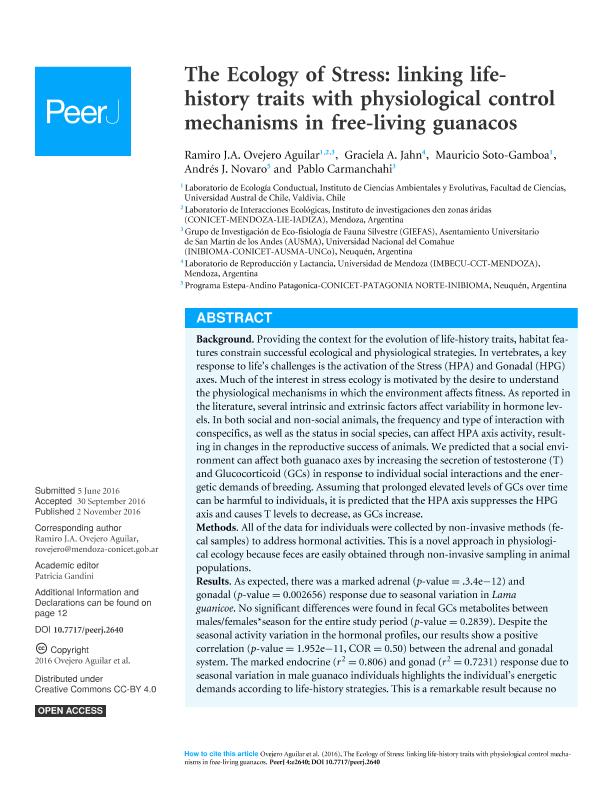Artículo
The Ecology of Stress: linking life- history traits with physiological control mechanisms in free-living guanacos
Ovejero Aguilar, Ramiro Jose Antonio ; Jahn, Graciela Alma
; Jahn, Graciela Alma ; Soto Gamboa, Mauricio; Novaro, Andres Jose
; Soto Gamboa, Mauricio; Novaro, Andres Jose ; Carmanchahi, Pablo Daniel
; Carmanchahi, Pablo Daniel
 ; Jahn, Graciela Alma
; Jahn, Graciela Alma ; Soto Gamboa, Mauricio; Novaro, Andres Jose
; Soto Gamboa, Mauricio; Novaro, Andres Jose ; Carmanchahi, Pablo Daniel
; Carmanchahi, Pablo Daniel
Fecha de publicación:
10/2016
Editorial:
PeeJ Inc
Revista:
PeerJ
ISSN:
2167-8359
Idioma:
Inglés
Tipo de recurso:
Artículo publicado
Clasificación temática:
Resumen
Providing the context for the evolution of life-history traits, habitat features constrain successful ecological and physiological strategies. In vertebrates, a key response to life’s challenges is the activation of the Stress (HPA) and Gonadal (HPG) axes. Much of the interest in stress ecology is motivated by the desire to understand the physiological mechanisms in which the environment affects fitness. As reported in the literature, several intrinsic and extrinsic factors affect variability in hormone levels. In both social and non-social animals, the frequency and type of interaction with conspecifics, as well as the status in social species, can affect HPA axis activity, resulting in changes in the reproductive success of animals. We predicted that a social environment can affect both guanaco axes by increasing the secretion of testosterone (T) and Glucocorticoid (GCs) in response to individual social interactions and the energetic demands of breeding. Assuming that prolonged elevated levels of GCs over time can be harmful to individuals, it is predicted that the HPA axis suppresses the HPG axis and causes T levels to decrease, as GCs increase.
Archivos asociados
Licencia
Identificadores
Colecciones
Articulos(IADIZA)
Articulos de INST. ARG DE INVEST. DE LAS ZONAS ARIDAS
Articulos de INST. ARG DE INVEST. DE LAS ZONAS ARIDAS
Citación
Ovejero Aguilar, Ramiro Jose Antonio; Jahn, Graciela Alma; Soto Gamboa, Mauricio; Novaro, Andres Jose; Carmanchahi, Pablo Daniel; The Ecology of Stress: linking life- history traits with physiological control mechanisms in free-living guanacos; PeeJ Inc; PeerJ; 4; e2640; 10-2016; 1-21
Compartir
Altmétricas



